sensor BMW X5 4.4I 2000 User Guide
[x] Cancel search | Manufacturer: BMW, Model Year: 2000, Model line: X5 4.4I, Model: BMW X5 4.4I 2000Pages: 201, PDF Size: 1.93 MB
Page 83 of 201
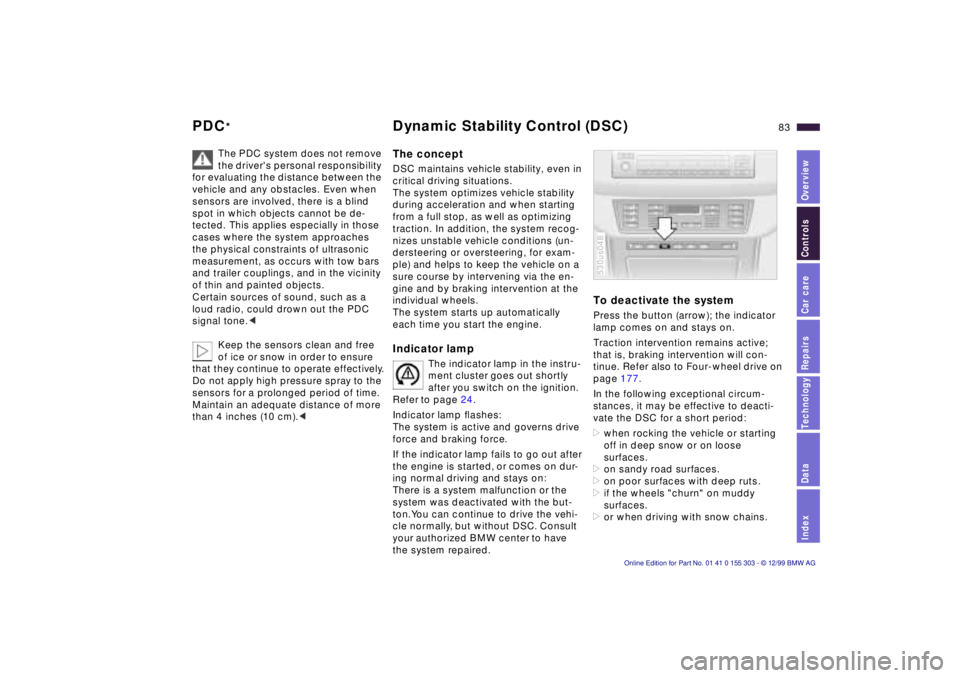
IndexDataTechnologyRepairsCar careControlsOverview
83n
PDC
*
Dynamic Stability Control (DSC)
The PDC system does not remove
the driver's personal responsibility
for evaluating the distance between the
vehicle and any obstacles. Even when
sensors are involved, there is a blind
spot in which objects cannot be de-
tected. This applies especially in those
cases where the system approaches
the physical constraints of ultrasonic
measurement, as occurs with tow bars
and trailer couplings, and in the vicinity
of thin and painted objects.
Certain sources of sound, such as a
loud radio, could drown out the PDC
signal tone.<
Keep the sensors clean and free
of ice or snow in order to ensure
that they continue to operate effectively.
Do not apply high pressure spray to the
sensors for a prolonged period of time.
Maintain an adequate distance of more
than 4 inches (10 cm).<
The concept DSC maintains vehicle stability, even in
critical driving situations.
The system optimizes vehicle stability
during acceleration and when starting
from a full stop, as well as optimizing
traction. In addition, the system recog-
nizes unstable vehicle conditions (un-
dersteering or oversteering, for exam-
ple) and helps to keep the vehicle on a
sure course by intervening via the en-
gine and by braking intervention at the
individual wheels.
The system starts up automatically
each time you start the engine. Indicator lamp
The indicator lamp in the instru-
ment cluster goes out shortly
after you switch on the ignition.
Refer to page 24.
Indicator lamp ßashes:
The system is active and governs drive
force and braking force.
If the indicator lamp fails to go out after
the engine is started, or comes on dur-
ing normal driving and stays on:
There is a system malfunction or the
system was deactivated with the but-
ton. You can continue to drive the vehi-
cle normally, but without DSC. Consult
your authorized BMW center to have
the system repaired.
To deactivate the system Press the button (arrow); the indicator
lamp comes on and stays on.
Traction intervention remains active;
that is, braking intervention will con-
tinue. Refer also to Four-wheel drive on
page 177.
In the following exceptional circum-
stances, it may be effective to deacti-
vate the DSC for a short period:
>when rocking the vehicle or starting
off in deep snow or on loose
surfaces.
>on sandy road surfaces.
>on poor surfaces with deep ruts.
>if the wheels "churn" on muddy
surfaces.
>or when driving with snow chains. 530us048
Page 91 of 201
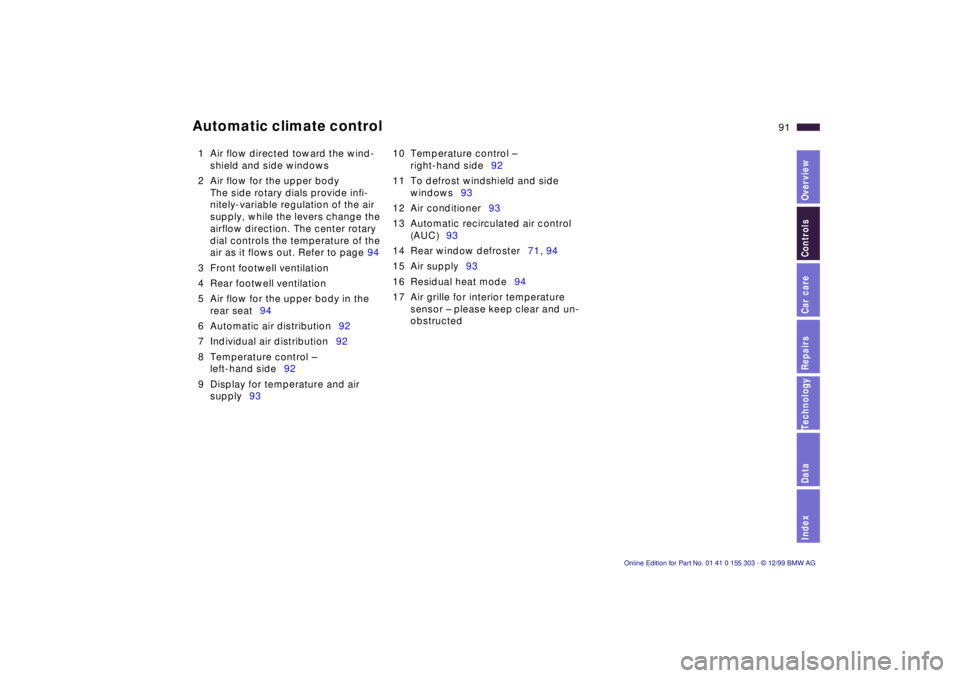
IndexDataTechnologyRepairsCar careControlsOverview
91n
Automatic climate control 1 Air flow directed toward the wind-
shield and side windows
2 Air flow for the upper body
The side rotary dials provide infi-
nitely-variable regulation of the air
supply, while the levers change the
airflow direction. The center rotary
dial controls the temperature of the
air as it flows out. Refer to page 94
3 Front footwell ventilation
4 Rear footwell ventilation
5 Air flow for the upper body in the
rear seat94
6 Automatic air distribution92
7 Individual air distribution92
8 Temperature control Ð
left-hand side92
9 Display for temperature and air
supply9310 Temperature control Ð
right-hand side92
11 To defrost windshield and side
windows93
12 Air conditioner93
13 Automatic recirculated air control
(AUC)93
14 Rear window defroster71, 94
15 Air supply93
16 Residual heat mode94
17 Air grille for interior temperature
sensor Ð please keep clear and un-
obstructed
Page 118 of 201

118n
General driving notes Catalytic converter
Brakes:
Do not drive with your foot resting
on the brake pedal. Even light but con-
sistent pedal pressure can lead to high
temperatures, brake wear and possibly
even brake failure.
Aquaplaning:
When driving on wet or slushy roads,
reduce vehicle speed. If you do not, a
wedge of water may form between the
tires and the road surface. This phe-
nomenon is referred to as aquaplaning
or hydroplaning. It is characterized by a
partial or complete loss of contact be-
tween the tires and the road surface.
The ultimate results are loss of steering
and braking control.
Cargo area cover:
Do not place heavy or hard objects on
the cargo area cover. These objects
could endanger vehicle occupants dur-
ing heavy brake applications or evasive
maneuvers.
Clothes hooks:
When suspending articles of clothing
from the hooks, be sure that they will
not obstruct the driver's vision. Do not
hang heavy objects on the hooks. If you
do so, they could cause personal injury
during braking or evasive maneuvers.< The catalytic converter reduces harmful
exhaust emissions.
It is designed for use with unleaded fuel
only. Even minute quantities of lead
would be enough to permanently dam-
age both the catalytic converter and the
system oxygen sensor.
To ensure efficient, trouble-free engine
operation and avoid potential damage:
>Be sure to comply with the scheduled
maintenance requirements.
>Fill the fuel tank well before it is
empty.
>When the battery is discharged, start
the engine with an outside starting
aid.
>Avoid other situations in which the
fuel is not burned, or burns incom-
pletely, such as engaging the starter
frequently or for extended periods, or
repeated start attempts in which the
engine does not start (stopping and
restarting an engine which is running
properly does not present a problem).
Never allow the engine to run with
any of the spark plug cables discon-
nected.
Page 143 of 201

IndexDataTechnologyRepairsCar careControlsOverview
143n
Caring for your vehicle Washing your vehicle You can have your new BMW washed
in an automatic car wash. Car wash
systems that do not employ brushes
are preferable.
Wipe away tough dirt and loosen and
remove dead insects before washing
the vehicle.
To prevent spots, avoid washing when
the hood is still warm, or immediately
after and during exposure to strong
sunlight.
When using an automatic car wash, be
sure that:
>The car wash system is suited for the
dimensions of your vehicle.
Before washing the vehicle in a
car wash, fold in the exterior mir-
rors manually, otherwise they may be
damaged on account of the width of the
vehicle.<
>No damage will occur on vehicles
with attached body accessories (such
as spoilers or antennas). If you are
uncertain, consult the manager of the
car wash.
>The wheels and tires of your vehicle
cannot be damaged by the convey-
ance devices of the car wash system.
>The vehicle is cleaned with minimum
brush pressure, and that ample water
is available for washing and rinsing.
Vehicles with rain sensor
*:
Clean the windshield regularly. Wax
from automatic car washes or insects,
for example, can cause malfunctions in
the function of the rain sensor.
Turn the rain sensor off in auto-
matic car washes. If you do not,
damage may occur if the wipers switch
on unintentionally.<
Parts of the vehicle that are inaccessi-
ble to the automatic washer Ñ such as
door sills, door and hood edges, etc. Ñ
should be cleaned by hand.
In the winter months, it is especially
important to ensure that the vehicle is
washed on a regular basis. Large quan-
tities of dirt and road salt are difficult to
remove, and they also cause damage to
the vehicle.
If spray wands or high-pressure
washers are used, be sure to
maintain an adequate distance between
the spray source and the vehicle's sur-
face. Inadequate distance and exces-
sive pressure can damage or weaken
the finish, making it more susceptible to
subsequent attack. In addition, mois-
ture could penetrate to vehicle compo-
nents, leading to long-term damage.<
When cleaning the headlamps,
please observe the following:
>Do not clean by wiping with a dry
cloth. Never use abrasives or strong
solvents to clean the covers.
>Remove dirt and contamination (such
as insects) by soaking with BMW Car
Shampoo and then rinsing with plenty
of water.
>Always use a deicer spray to remove
accumulated ice and snow Ð never
use a scraper.<
After washing the vehicle, apply
the brakes briefly to dry them.
Braking efficiency might otherwise be
reduced by the moisture and the brake
rotors could also be corroded.<
Page 175 of 201
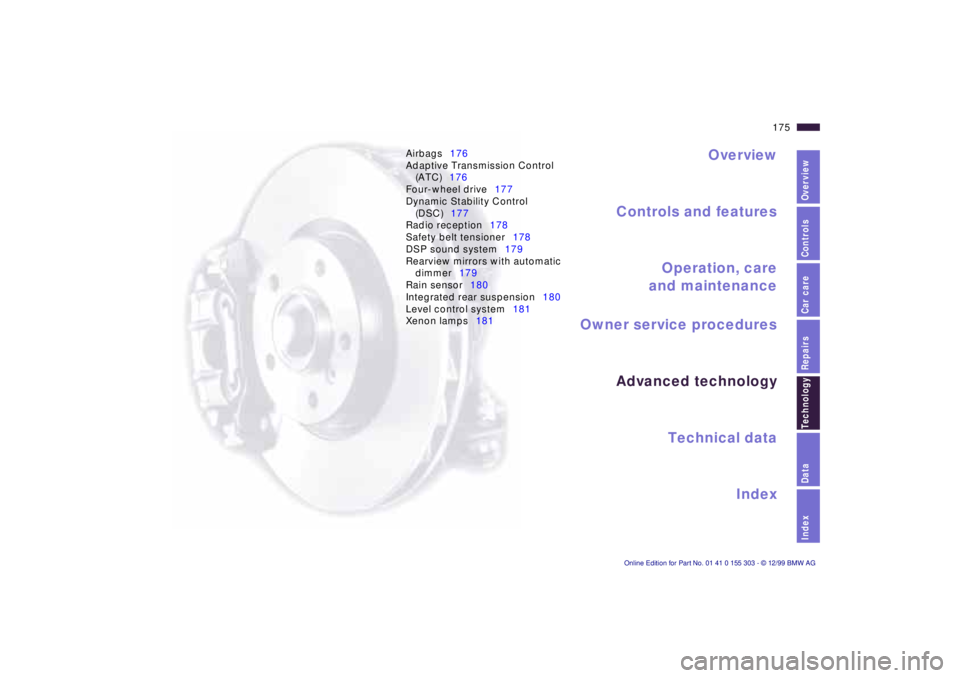
IndexDataTechnologyRepairsCar careControlsOverview
Overview
Controls and features
Operation, care
and maintenance
Owner service procedures
Technical data
Index Advanced technology
175n
Airbags176
Adaptive Transmission Control
(ATC)176
Four-wheel drive177
Dynamic Stability Control
(DSC)177
Radio reception178
Safety belt tensioner178
DSP sound system179
Rearview mirrors with automatic
dimmer179
Rain sensor180
Integrated rear suspension180
Level control system181
Xenon lamps181
Technol-
Page 176 of 201
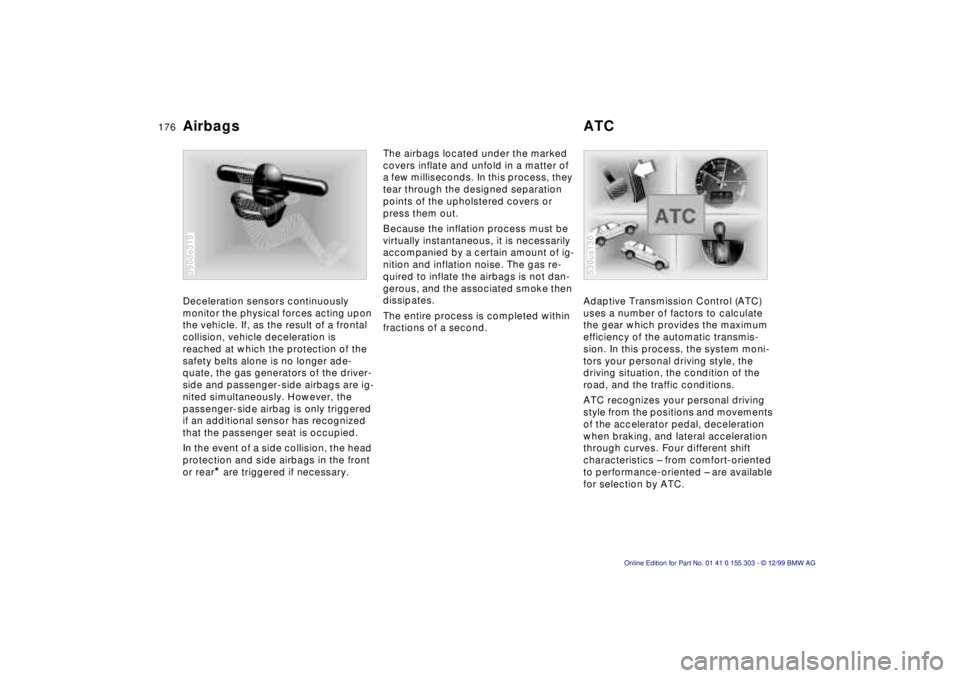
176n
Deceleration sensors continuously
monitor the physical forces acting upon
the vehicle. If, as the result of a frontal
collision, vehicle deceleration is
reached at which the protection of the
safety belts alone is no longer ade-
quate, the gas generators of the driver-
side and passenger-side airbags are ig-
nited simultaneously. However, the
passenger-side airbag is only triggered
if an additional sensor has recognized
that the passenger seat is occupied.
In the event of a side collision, the head
protection and side airbags in the front
or rear
* are triggered if necessary.
390de319
The airbags located under the marked
covers inflate and unfold in a matter of
a few milliseconds. In this process, they
tear through the designed separation
points of the upholstered covers or
press them out.
Because the inflation process must be
virtually instantaneous, it is necessarily
accompanied by a certain amount of ig-
nition and inflation noise. The gas re-
quired to inflate the airbags is not dan-
gerous, and the associated smoke then
dissipates.
The entire process is completed within
fractions of a second. Adaptive Transmission Control (ATC)
uses a number of factors to calculate
the gear which provides the maximum
efficiency of the automatic transmis-
sion. In this process, the system moni-
tors your personal driving style, the
driving situation, the condition of the
road, and the traffic conditions.
ATC recognizes your personal driving
style from the positions and movements
of the accelerator pedal, deceleration
when braking, and lateral acceleration
through curves. Four different shift
characteristics Ð from comfort-oriented
to performance-oriented Ð are available
for selection by ATC.
530us130
Airbags ATC
Page 177 of 201
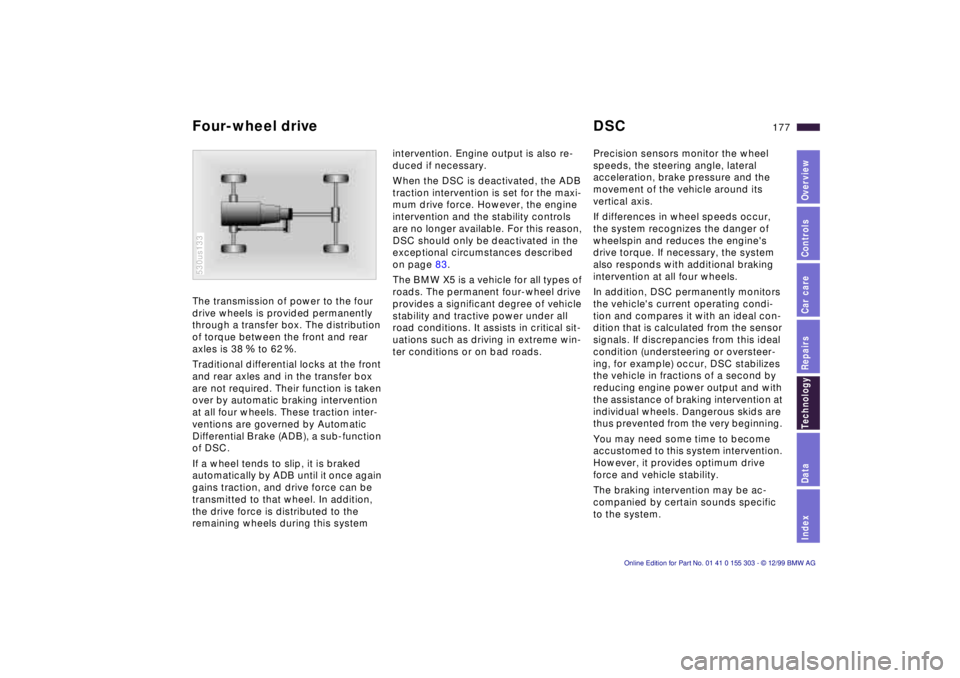
IndexDataTechnologyRepairsCar careControlsOverview
177n
The transmission of power to the four
drive wheels is provided permanently
through a transfer box. The distribution
of torque between the front and rear
axles is 38% to 62%.
Traditional differential locks at the front
and rear axles and in the transfer box
are not required. Their function is taken
over by automatic braking intervention
at all four wheels. These traction inter-
ventions are governed by Automatic
Differential Brake (ADB), a sub-function
of DSC.
If a wheel tends to slip, it is braked
automatically by ADB until it once again
gains traction, and drive force can be
transmitted to that wheel. In addition,
the drive force is distributed to the
remaining wheels during this system
530us133
intervention. Engine output is also re-
duced if necessary.
When the DSC is deactivated, the ADB
traction intervention is set for the maxi-
mum drive force. However, the engine
intervention and the stability controls
are no longer available. For this reason,
DSC should only be deactivated in the
exceptional circumstances described
on page 83.
The BMW X5 is a vehicle for all types of
roads. The permanent four-wheel drive
provides a significant degree of vehicle
stability and tractive power under all
road conditions. It assists in critical sit-
uations such as driving in extreme win-
ter conditions or on bad roads. Precision sensors monitor the wheel
speeds, the steering angle, lateral
acceleration, brake pressure and the
movement of the vehicle around its
vertical axis.
If differences in wheel speeds occur,
the system recognizes the danger of
wheelspin and reduces the engine's
drive torque. If necessary, the system
also responds with additional braking
intervention at all four wheels.
In addition, DSC permanently monitors
the vehicle's current operating condi-
tion and compares it with an ideal con-
dition that is calculated from the sensor
signals. If discrepancies from this ideal
condition (understeering or oversteer-
ing, for example) occur, DSC stabilizes
the vehicle in fractions of a second by
reducing engine power output and with
the assistance of braking intervention at
individual wheels. Dangerous skids are
thus prevented from the very beginning.
You may need some time to become
accustomed to this system intervention.
However, it provides optimum drive
force and vehicle stability.
The braking intervention may be ac-
companied by certain sounds specific
to the system.
Four-wheel drive DSC
Page 179 of 201
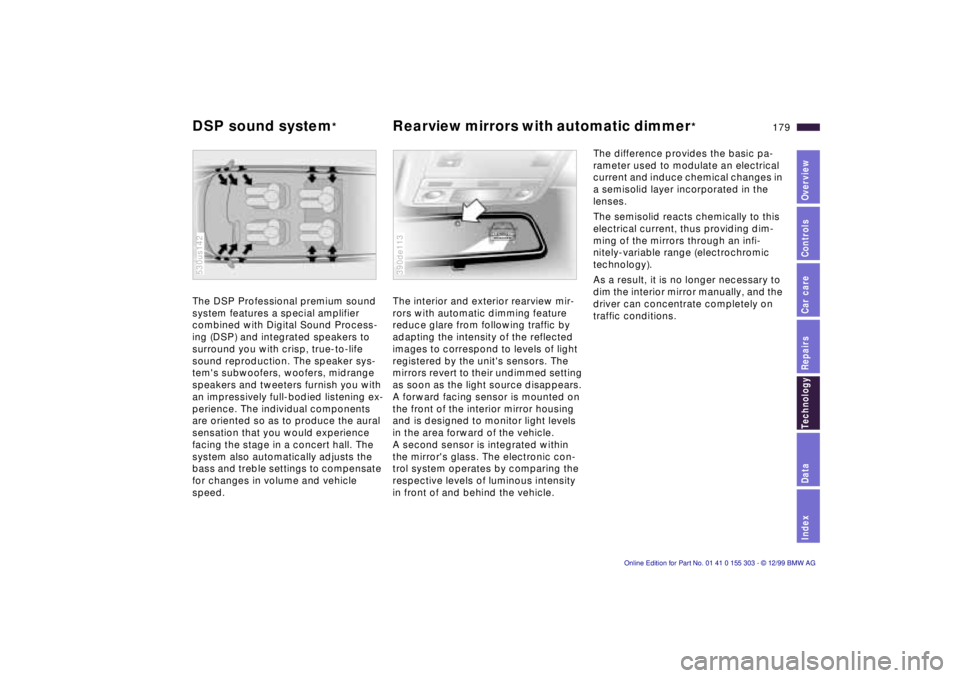
IndexDataTechnologyRepairsCar careControlsOverview
179n
DSP sound system
*
Rearview mirrors with automatic dimmer
*
The DSP Professional premium sound
system features a special amplifier
combined with Digital Sound Process-
ing (DSP) and integrated speakers to
surround you with crisp, true-to-life
sound reproduction. The speaker sys-
tem's subwoofers, woofers, midrange
speakers and tweeters furnish you with
an impressively full-bodied listening ex-
perience. The individual components
are oriented so as to produce the aural
sensation that you would experience
facing the stage in a concert hall. The
system also automatically adjusts the
bass and treble settings to compensate
for changes in volume and vehicle
speed. 530us142
The interior and exterior rearview mir-
rors with automatic dimming feature
reduce glare from following traffic by
adapting the intensity of the reflected
images to correspond to levels of light
registered by the unit's sensors. The
mirrors revert to their undimmed setting
as soon as the light source disappears.
A forward facing sensor is mounted on
the front of the interior mirror housing
and is designed to monitor light levels
in the area forward of the vehicle.
A second sensor is integrated within
the mirror's glass. The electronic con-
trol system operates by comparing the
respective levels of luminous intensity
in front of and behind the vehicle. 390de113
The difference provides the basic pa-
rameter used to modulate an electrical
current and induce chemical changes in
a semisolid layer incorporated in the
lenses.
The semisolid reacts chemically to this
electrical current, thus providing dim-
ming of the mirrors through an infi-
nitely-variable range (electrochromic
technology).
As a result, it is no longer necessary to
dim the interior mirror manually, and the
driver can concentrate completely on
traffic conditions.
Page 180 of 201

180n
Rain sensor
*
Integrated rear suspension
The rain sensor controls windshield
wiper operation, depending on how wet
the windshield is.
Infrared light is carried along the sur-
face of the windshield in an optical con-
ductor in such a manner that it is re-
flected completely when the windshield
is dry. The quantity of reflected light is
measured.
If the window is covered with beads of
water, the amount of light that is re-
flected is decreased since the infrared
light at the surface of the windshield
can then escape. The quantity of re-
flected light is thus a means of gauging
the degree of wetness on the wind-
shield. 390de133
When the system is set to the "Intermit-
tent" wiper speed, the wipers react im-
mediately Ñ if water is splashed onto
the windshield by vehicles traveling
ahead of you, for example. As a result,
the rain sensor provides a contribution
to driving safety and comfort.
This axle is based on the same multi-
link principle as that in series-7 vehi-
cles. The axle's kinematics and elastic
kinematics are critical for wheel control
Ñ a significant prerequisite for achieving
the objective of exceptional onroad
handling characteristics with this vehi-
cle concept.
In order to reduce unsprung mass, the
wheel carriers and the swing arm are
made of aluminum.
For an outstanding quality in acoustics
and vehicle oscillation characteristics,
the differential is isolated with double
elasticity through a chassis sub-frame
toward the vehicle body.
530us131
Page 181 of 201
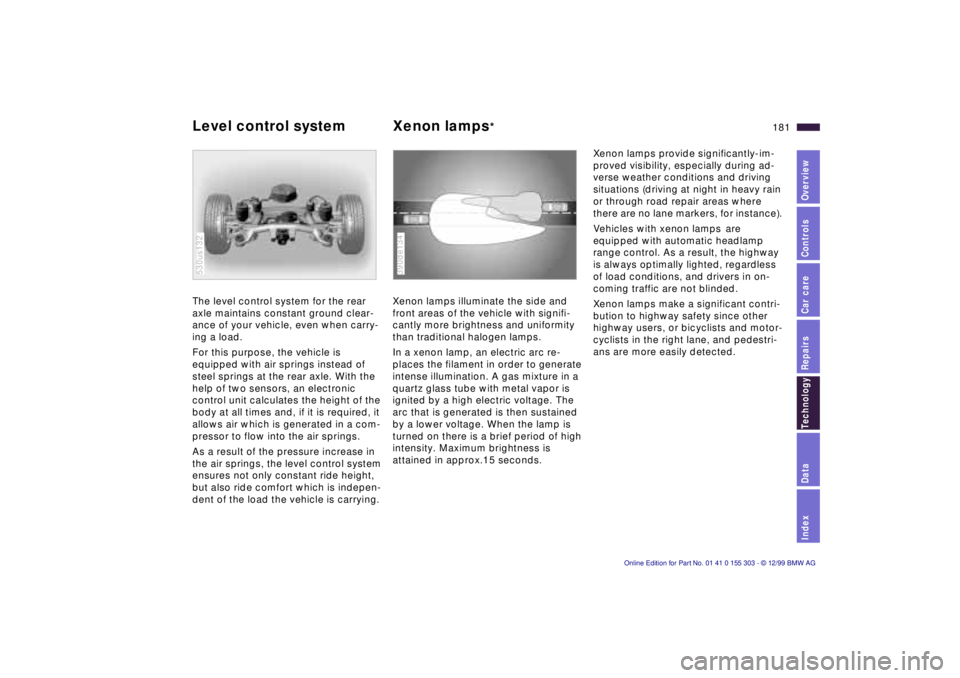
IndexDataTechnologyRepairsCar careControlsOverview
181n
Level control system
Xenon lamps
*
The level control system for the rear
axle maintains constant ground clear-
ance of your vehicle, even when carry-
ing a load.
For this purpose, the vehicle is
equipped with air springs instead of
steel springs at the rear axle. With the
help of two sensors, an electronic
control unit calculates the height of the
body at all times and, if it is required, it
allows air which is generated in a com-
pressor to flow into the air springs.
As a result of the pressure increase in
the air springs, the level control system
ensures not only constant ride height,
but also ride comfort which is indepen-
dent of the load the vehicle is carrying. 530us132
Xenon lamps illuminate the side and
front areas of the vehicle with signifi-
cantly more brightness and uniformity
than traditional halogen lamps.
In a xenon lamp, an electric arc re-
places the filament in order to generate
intense illumination. A gas mixture in a
quartz glass tube with metal vapor is
ignited by a high electric voltage. The
arc that is generated is then sustained
by a lower voltage. When the lamp is
turned on there is a brief period of high
intensity. Maximum brightness is
attained in approx.15 seconds. 390de134
Xenon lamps provide significantly-im-
proved visibility, especially during ad-
verse weather conditions and driving
situations (driving at night in heavy rain
or through road repair areas where
there are no lane markers, for instance).
Vehicles with xenon lamps
are
equipped with automatic headlamp
range control. As a result, the highway
is always optimally lighted, regardless
of load conditions, and drivers in on-
coming traffic are not blinded.
Xenon lamps make a significant contri-
bution to highway safety since other
highway users, or bicyclists and motor-
cyclists in the right lane, and pedestri-
ans are more easily detected.